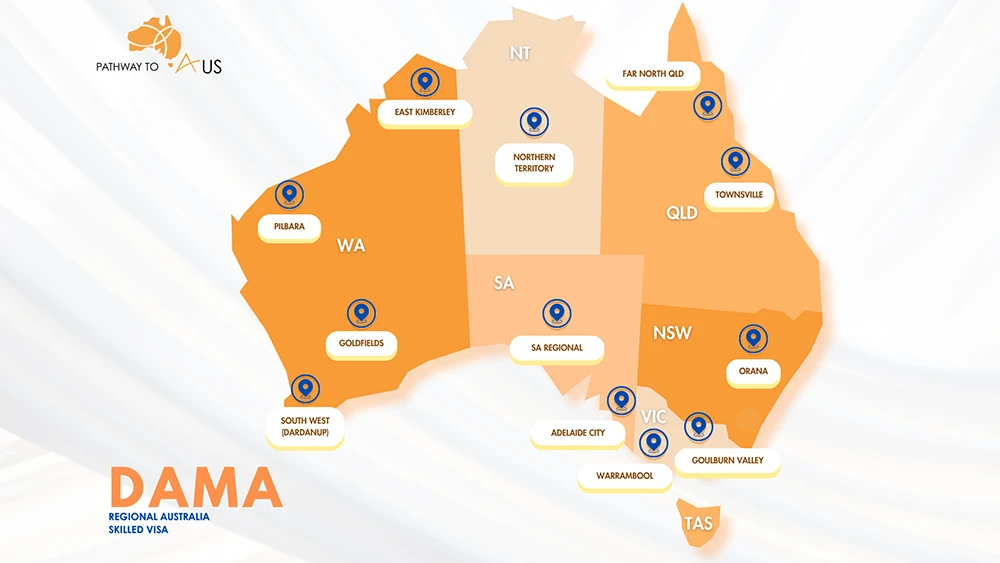This article is going to explain the DAMA Visa process
What is DAMA?
DAMA stands for Designated Area Migration Agreement. This is a special type of employer-sponsored visa in a regional area.
The DAMA visa often allows applicants to apply for employer-sponsored visas in types of occupations that may not be allowed in most areas in Australia, at lower levels of work experience requirements and provides a pathway to PR (often up to the aged of 55!)
Although the information is general in nature, with DAMA applications, it is common for visa applicants to get concessions on things such as:
- The type of occupation that can apply
- The Work Experience
- The Age Requirement
- The English level required
- The Salary Required
- Pathways to Permanent Residency
Currently, there are twelve DAMA Agreements in place, but this is expected to only grow to more regions in the future.
*Please note, each area has a different list of occupations and a different list of eligibility requirements.
- Adelaide City Technology and Innovation Advancement, SA
- East Kimberley, WA
- Far North Queensland, QLD
- Goulburn Valley, VIC
- Great South Coast, VIC
- Northern Territory, NT
- Orana, NSW
- Pilbara, WA
- South Australia Regional, SA
- South West, WA
- The Goldfields, WA
- Townsville, QLD

Let’s take a look at an example – the occupation of a Childcare Worker.
This occupation is on quite a few DAMA Occupations lists and many DAMA agreements only require 1 year of work experience in order to apply for the employer-sponsored visa. This also provides a pathway to apply for permanent residency after 3 years.
—
Another example is the occupation of Aged or Disabled care
Like childcare, this is also on certain DAMA Occupations Lists with many DAMA agreements only requiring 1 year of work experience (of at least 20 hours per week) and a relevant Cert III qualification in order to apply for the employer-sponsored visa. This also provides a pathway to apply for permanent residency after 3 years.
—
What is the process?
The process of applying for these visas can vary amongst each DAMA area (however, they are generally pretty similar). Please note that these visas will always be employer-sponsored visas, so you will need an employer to sponsor you!
As an example, we will look at the DAMA for South Australia Outer Regional areas with the 482 visa pathway to PR.
Susy is 46 years old. She has recently finished the Diploma of Early Childhood Education and Care in Australia. She has 1 year of work experience as a childcare worker and has been offered sponsorship by a company in regional South Australia. Susy knows that by being sponsored, she can obtain a path to PR (even though she is older than 45).
The Outer Regional South Australia DAMA agreements provide concessions by:
- Only requiring 1 year of work experience
- It allows sponsorship as only a childcare worker
- Requires slightly lower English requirements
- And it provides a path to PR up to the age of 55.
Essentially the beginning of the process is all undertaken by the employer (or their migration agents). It is very similar to the standard employer-sponsored visa process, however, there are 2 additional steps.
Step 1: The childcare centre must undertake the required labour market testing (job advertisements) and lodge a DAMA Endorsement. (This is very similar to the nomination, but it is with the individual DAMA area).
Step 2: Once the DAMA endorsement has been approved you will receive an endorsement letter and then be able to apply for the Labour Agreement with immigration.
Step 3: Once the Labour Agreement has been approved you will then lodge the Nomination with immigration (like any other employer-sponsored visa)
Step 4: And once you have lodged the nomination, you can then apply for the visa (Usually it is a standard 482 visa, but can be a 494).
—
After 3 years of working on the 482 visa, the applicant will then be able to apply for the permanent 186 ENS visa.
Please note that the above information is general in nature and you should contact a migration agent to find out more about your specific circumstances.




